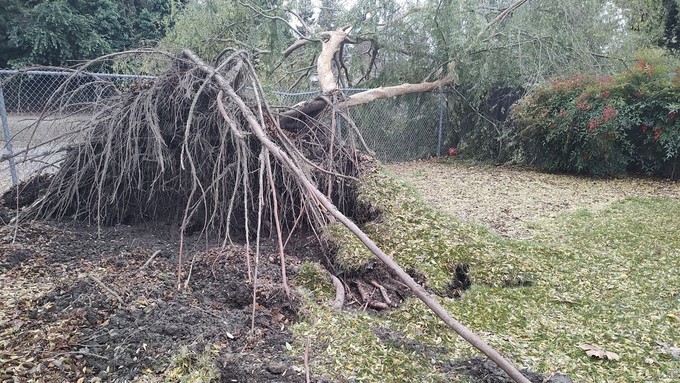
Watch out for leaning trunks and sagging branches

This 25-foot elm in the Pocket neighborhood of Sacramento came down during the New Year's Eve storm. Note the fissures in the lawn. Debbie Arrington
With the downpour on New Year’s Eve, 2022 made up for what had been a very dry year. And 2023 is starting soggy, too.
Record rain had a huge impact on the greater Sacramento area with flooding in south Sacramento County, major power outages and fallen trees all over the place.
According to the National Weather Service, downtown Sacramento received 2.37 inches on New Year’s Eve – a record for that date – and 4.81 inches fell since Christmas. That brought December’s total to 9.5 inches – almost triple the normal (3.49 inches) for that month.
December brought our seasonal total to 10.66 inches since Oct. 1, the start of our “water year.” That total is 148% of normal for that period, which is good news for our reservoirs and drought perspective.
More rain is on the way, says the weather service. Today (Monday) will see a quick-moving storm with less than one-third inch predicted for downtown Sacramento. The real threat comes Wednesday and Thursday; over 48 hours, an estimated 2.5 to 3 inches of rain is expected to fall.
All this moisture puts trees at risk. Be on the lookout for sagging branches and leaning trees.
Water accumulates in the needles of evergreens, stressing limbs with the extra weight. Horizontal limbs are at the greatest risk of breaking. The tree may groan or creak, often a signal that a branch is about to fall – or the whole tree is coming down.
Lawn trees – particularly those affected by drought – are especially susceptible to uprooting; all it takes are strong winds to accompany that moisture. Need proof? On New Year’s Eve, dozens of trees fell in Sacramento neighborhoods, pushed over by 40 mph gusts.
Lawn trees tend to have shallow roots and less of a foothold. If the soil is soggy, those roots give way.
Before the tree falls, there are usually warning signs, such as fissures in the soil around the tree. That’s a sign the roots are pulling loose.
If you see such fissures, stay away from the tree and call a certified arborist immediately. Your tree may be saved with quick action (and support). Never walk under a leaning tree; the soil may be too unstable.
For more information on tree care and finding an arborist, go to: www.sactree.org.
Comments
0 comments have been posted.Sacramento Digs Gardening to your inbox.
Sites We Like
Garden Checklist for week of May 5
Survey your garden after the May 4 rainstorm. Heavy rain and gusty winds can break the neck of large flowers such as roses. Also:
* Keep an eye on new transplants or seedlings; they could take a pounding from the rain.
* Watch out for powdery mildew. Warmth following moist conditions can cause this fungal disease to “bloom,” too. If you see a leaf that looks like it’s dusted with powdered sugar, snip it off.
* After the storm, start setting out tomato transplants, but wait on the peppers and eggplants (they want warmer nights). Pinch off any flowers on new transplants to make them concentrate on establishing roots instead of setting premature fruit.
* Trim dead flowers but not leaves from spring-flowering bulbs such as daffodils and tulips. Those leaves gather energy to create next year's flowers. Also, give the bulbs a fertilizer boost after bloom.
* Pinch chrysanthemums back to 12 inches for fall flowers. Cut old stems to the ground.
* Mulch around plants to conserve moisture and control weeds.
* From seed, plant beans, beets, cantaloupes, carrots, corn, cucumbers, melons, pumpkins, radishes and squash.
* Plant onion sets.
* In the flower garden, plant seeds for asters, cosmos, celosia, marigolds, salvia, sunflowers and zinnias. Transplant petunias, zinnias, geraniums and other summer bloomers.
* Plant perennials and dahlia tubers for summer bloom.
* Don’t wait; plant summer bulbs, such as gladiolus and tuberous begonias.
* Harvest cabbage, lettuce, peas and green onions.